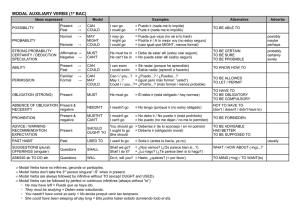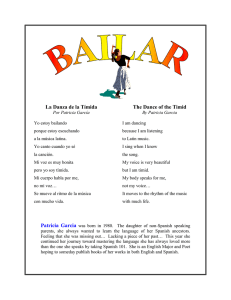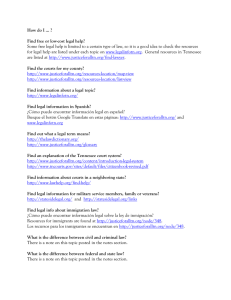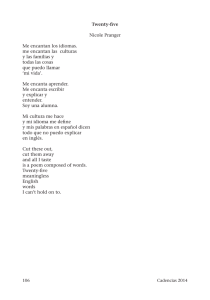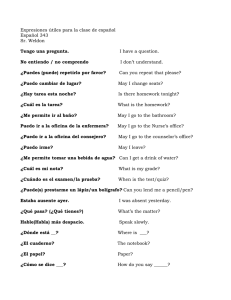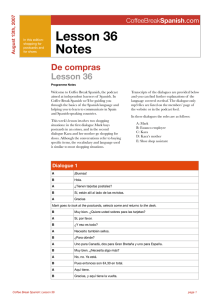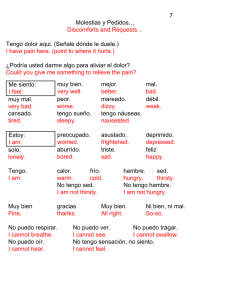Lesson 25 Notes
Anuncio
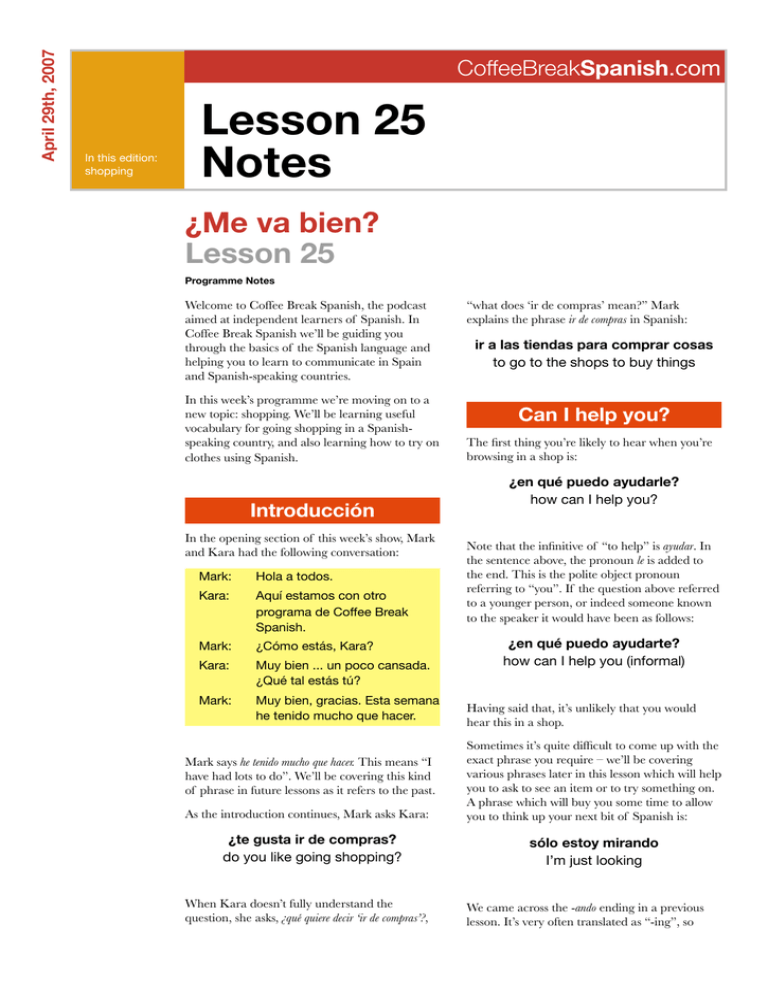
April 29th, 2007 CoffeeBreakSpanish.com In this edition: shopping Lesson 25 Notes ¿Me va bien? Lesson 25 Programme Notes Welcome to Coffee Break Spanish, the podcast aimed at independent learners of Spanish. In Coffee Break Spanish we’ll be guiding you through the basics of the Spanish language and helping you to learn to communicate in Spain and Spanish-speaking countries. In this week’s programme we’re moving on to a new topic: shopping. We’ll be learning useful vocabulary for going shopping in a Spanishspeaking country, and also learning how to try on clothes using Spanish. “what does ‘ir de compras’ mean?” Mark explains the phrase ir de compras in Spanish: ir a las tiendas para comprar cosas to go to the shops to buy things Can I help you? The first thing you’re likely to hear when you’re browsing in a shop is: ¿en qué puedo ayudarle? how can I help you? Introducción In the opening section of this week’s show, Mark and Kara had the following conversation: Mark: Hola a todos. Kara: Aquí estamos con otro programa de Coffee Break Spanish. Mark: ¿Cómo estás, Kara? Kara: Muy bien ... un poco cansada. ¿Qué tal estás tú? Mark: Muy bien, gracias. Esta semana he tenido mucho que hacer. Mark says he tenido mucho que hacer. This means “I have had lots to do”. We’ll be covering this kind of phrase in future lessons as it refers to the past. As the introduction continues, Mark asks Kara: ¿te gusta ir de compras? do you like going shopping? When Kara doesn’t fully understand the question, she asks, ¿qué quiere decir ‘ir de compras’?, 1 Note that the infinitive of “to help” is ayudar. In the sentence above, the pronoun le is added to the end. This is the polite object pronoun referring to “you”. If the question above referred to a younger person, or indeed someone known to the speaker it would have been as follows: ¿en qué puedo ayudarte? how can I help you (informal) Having said that, it’s unlikely that you would hear this in a shop. Sometimes it’s quite difficult to come up with the exact phrase you require – we’ll be covering various phrases later in this lesson which will help you to ask to see an item or to try something on. A phrase which will buy you some time to allow you to think up your next bit of Spanish is: sólo estoy mirando I’m just looking We came across the -ando ending in a previous lesson. It’s very often translated as “-ing”, so mirando means “looking”, and cantando means “singing”, etc. ¿cuánto cuesta? how much is it? If you were asked ¿lo quiere? or ¿la quiere? which means “do you want it?” you could say: no estoy seguro/a I am not sure (m/f) If there is more than one item, you would use the plural form of the verb: ¿cuánto cuestan? how much are they? You can then say: vuelvo más tarde I’ll come back later Note that vuelvo literally means “I come back”, ie. in the present tense. In English we would tend to say “I will come back later”, but it’s perfectly natural in Spanish to say “I come back later”. Look at the following short dialogue. Note that dep. stands for dependiente, the word for “shop assistant”: Dep,: ¿En qué puedo ayudarle? Kara: Sólo estoy mirando Kara picks up an object and is looking at it. The shop assistant asks her: Dep,: ¿Lo quiere? Kara: No estoy segura. Vuelvo más tarde. Kara says, “I’m not sure. I’ll come back later”. If you want to buy the item, you can say: me lo llevo I’ll take it Note that there are other ways of saying the same thing. You could say: quiero comprar esto I want to buy this Equally you could say: quiero comprarlo I want to buy it Paying for things Having established that you’re interested in a particular item, you may want to ask how much it costs: Coffee Break Spanish: Lesson 25 Depending on which country you’re in, you could be told the price in euros, pesos, etc. Here’s a selection of currencies from various Spanishspeaking areas: Argentina peso 100 centavos Belize dólar 100 centavos Bolivia peso 100 centavos Chile peso (chileno) 100 escudos Colombia peso 100 centavos Costa Rica peso 100 céntimos Ecuador quetzal 100 centavos El Salvador colón 100 centavos Guatemala quetzal 100 centavos Guyana dólar guyanés 100 centavos Haiti gourde 100 céntimos Honduras lempira 100 centavos Mexico peso 100 centavos Nicaragua córdoba 100 centavos Panama balboa 100 centésimos Paraguay guaraní 100 céntimos peru sol 100 centavos Puerto Rico* dólar 100 centavos Rebública Dominicana peso 100 centavos page 2 Spain euro 100 céntimos Uruguay peso 100 centésimos Venezuela bolivar 100 cénitmos *Note that the official currency in Puerto Rico is the US Dollar and, as such, is referred to as both the Spanish dólar and the English “dollar”. If you want to pay buy credit card, you can ask: ¿puedo pagar con tarjeta de crédito? can I pay buy credit card? Note that pagar is the infinitive: the word puedo meaning “I can” or “can I” is almost always followed by the infinitive. If you are trying to pay by credit card you may well be asked for some for identification: ¿puedo ver su DNI? can I see some identification? The abbreviation DNI stands for documento nacional de identificación, referring to a national identification document. In most cases tourists would provide a passport. Indeed, you may hear: ¿puedo ver su pasaporte? can I see your passport? Whenever you’re handing something over, it is polite to say: aquí tiene here you are Kara: ¿Puedo pagar con tarjeta de crédito? Dep.: Claro que sí. ¿Puedo ver su pasaporte, por favor? Kara: Sí. Aquí tiene. Dep.: Gracias. No olvides... There are certain other items you may require when shopping: un recibo a receipt una bolsa a bag Note that the word bolsa is used for a plastic or paper bag in a shop. If you want to buy a leather bag you’re more likely to use the word bolso. These can be added to the phrase “can you give me”: ¿me puede dar ... ? can you give me ... ? ¿me puede dar un recibo? can you give me a receipt? ¿me puede dar una bolsa? can you give me a bag? Shopping for clothes You can also say: tenga here you are Have a look at the following conversation in which Kara decides to buy a hat, un sombrero: Kara: Me lo llevo. Dep.: Muy bien. Kara: ¿Cuánto cuesta? Dep.: El sombrero cuesta quince euros. Coffee Break Spanish: Lesson 25 If you want to try something on, you can use this phrase: ¿puedo probarme esto, por favor? can I try this on, please? The word probar literally means “to try”. In this situation it’s used with the pronoun me and means “to try on”. Esto simply means “this”. We’ll be talking more about esto in next week’s lesson. The fitting rooms in a shop are: page 3 los probadores the fitting rooms If you feel something doesn’t fit you, you can say: ¿dónde están los probadores? where are the fitting rooms? Using the word demasiado, you can come up with the following reasons: no me queda bien it doesn’t fit me You can ask: es demasiado grande it is too big If you’re trying something on, you may want to say that it fits you: me queda bien it fits me You can, of course, turn this into a question: ¿me queda bien? does it fit me? es demasiado pequeño/a it is too small You can also say if you like or don’t like something: me gusta I like it The shop assistant may answer: no me gusta I don’t like it sí, le queda bien yes, it fits you CoffeeBreakSpanish: Lesson 25 - Basic Vocabulary ir de compras to go shopping ¿en qué puedo ayudarle? how can I help you? mirar to look estoy mirando I am looking sólo estoy mirando I am just looking no estoy seguro/a I am not sure vuelvo más tarde I’ll come back later me lo llevo I’ll take it quiero comprar esto I want to buy this ¿lo quiere? / ¿la quiere? do you want it? ¿cuánto cuesta? how much is it? ¿cuánto cuestan? how much are they? la tarjeta de crédito credit card ¿puedo pagar con tarjeta de crédito? can I pay with a credit card? el DNI ID el documento nacional de identificación national identification document Coffee Break Spanish: Lesson 25 page 4 el pasaporte passport ¿puedo ver su pasaporte? can I see your passport? aquí tiene here you are tenga here you are ¿me puede dar ... ? can you give me ... ? un recibo a receipt una bolsa a bag ¿puedo probarme esto? can I try this on? los probadores fitting rooms ¿dónde están los probadores? where are the fitting rooms? me queda bien it fits me no me queda bien it doesn’t fit me es demasiado grande it is too big es demasiado pequeño it is too small me gusta I like it no me gusta I don’t like it CoffeeBreakSpanish: Lesson 25 - Bonus Vocabulary tengo que pensarlo I have to think about it ¿es para un regalo? is it for a present? ¿puede envolverlo, por favor? can you wrap it, please? estoy buscando ... I’m looking for ... una camiseta a t-shirt una camisa a shirt un jersey a jumper una falda a skirt un par de zapatos a pair of shoes un par de sandallas a pair of sandals un par de pantalones a pair of trousers CoffeeBreakSpanish.com All materials ©Copyright Radio Lingua International 2007 Coffee Break Spanish: Lesson 25 page 5
